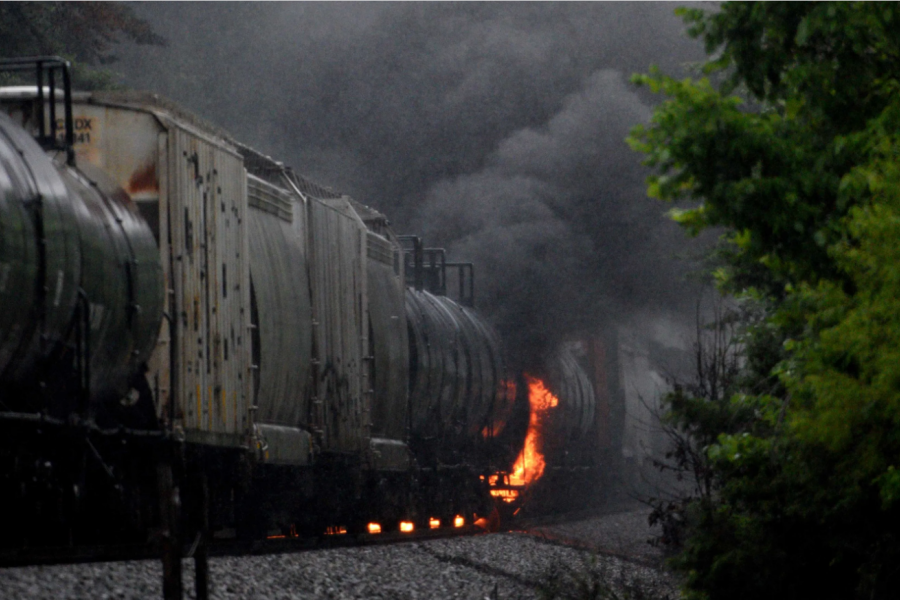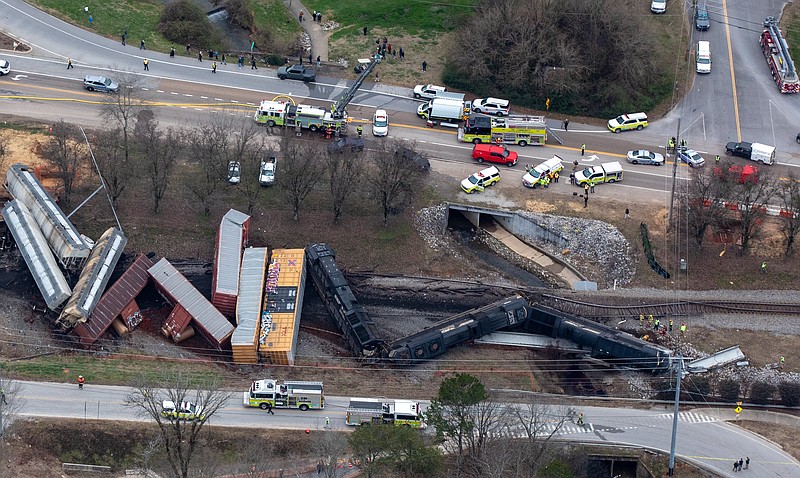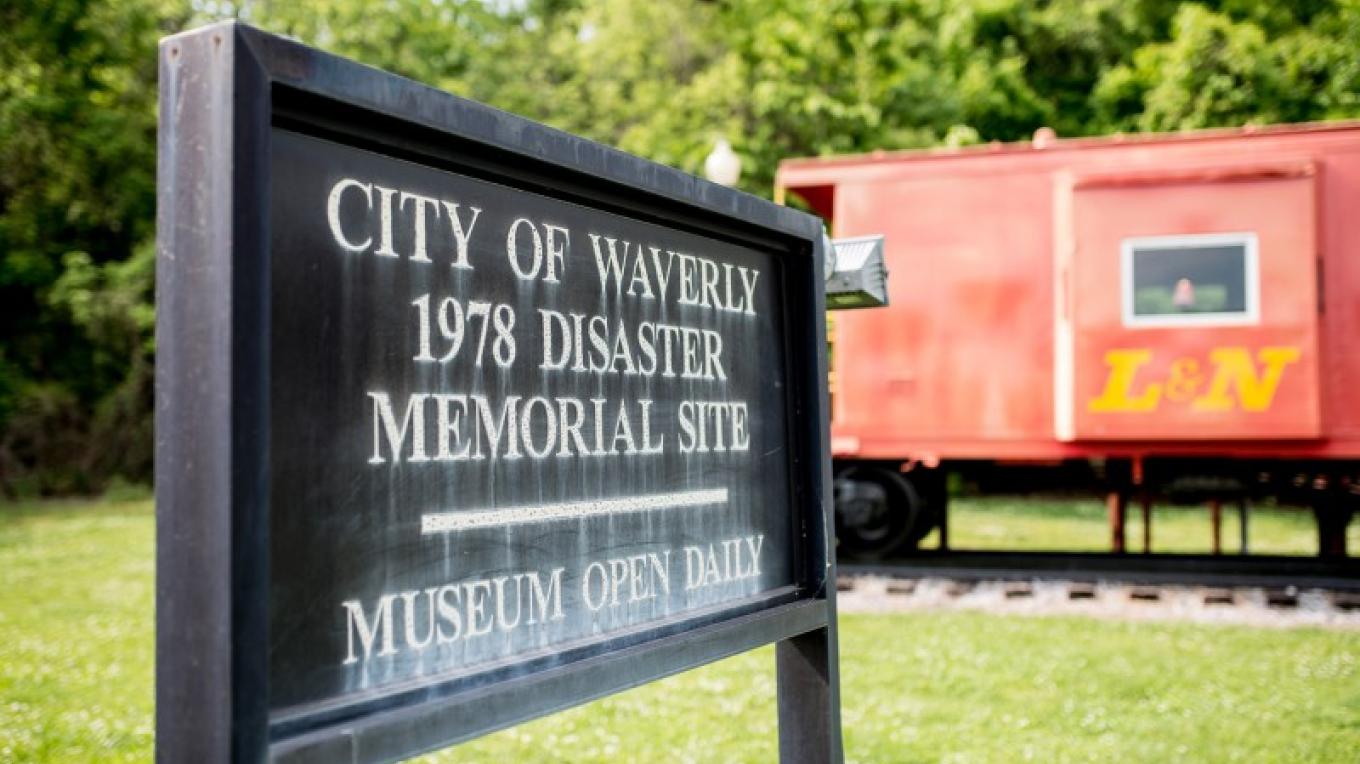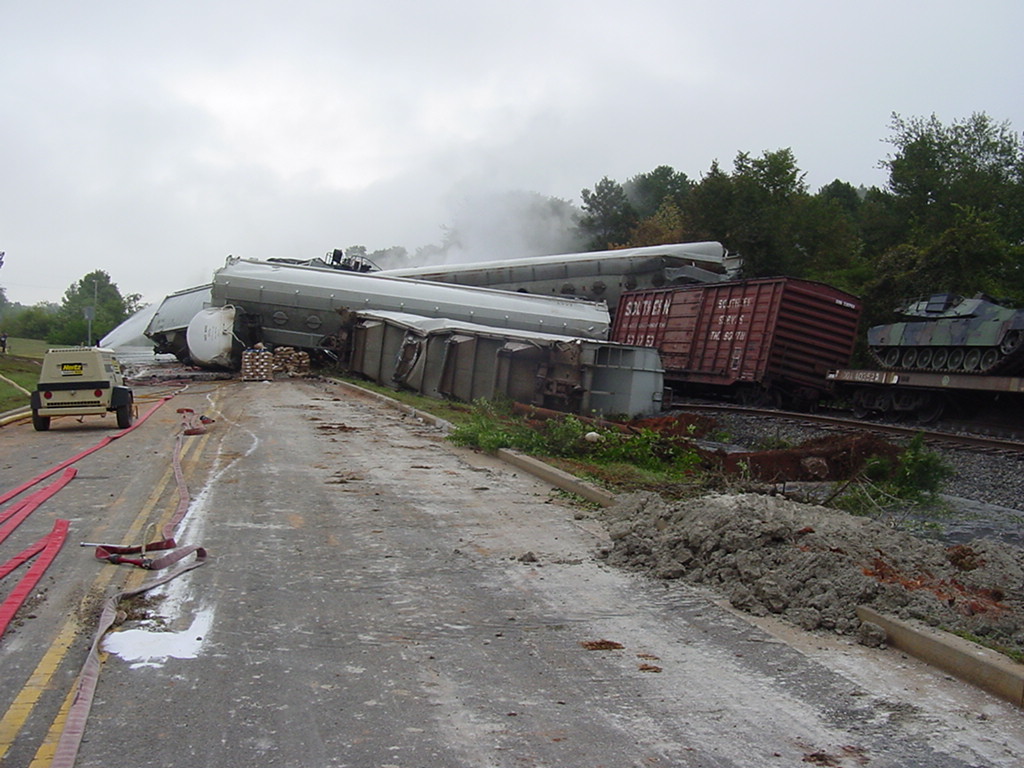Resources, training can help mitigate local risk in derailments

BY KATE COIL
TML Communications Specialist
Following the train derailment and resulting toxic spill in East Palestine, Ohio, in February, many community members and local leaders are asking questions about their own municipality’s preparedness for a similar incident.
The state of Tennessee presently has 28 railroad companies operating on 2,604 miles of track, many of which pass through towns and cities throughout the state. Tennessee itself is no stranger to train derailments including the derailment of a train carrying a concrete barrier after it was struck by a semi-truck in Collegedale in December 2023, the 2015 CSX derailment that spilled hazardous materials in Maryville, a 2002 derailment in Farragut that resulted in the release of oleum or fuming sulfuric acid, and the famous 1978 tank car explosion in downtown Waverly that followed a train derailment and killed 16 people.

Donald Pannell, a fire management consultant with the University of Tennessee Municipal Technical Advisory Service (UT-MTAS), said local emergency responders are often on the front lines of these incidents.
“The risks to emergency responders and the public vary greatly regarding the transportation of hazardous materials through Tennessee communities,” Pannell said. “Though classified as hazardous, many of these types of chemicals are essential in the manufacturing and production processes of everyday goods and services. The health effects on individuals from exposure to some of these chemicals can be severe, and likewise, the effects on the environment can be highly detrimental and long-lasting. As evident from the derailment in East Palestine, the costs associated with clean-up is significant and the full impact on the community can be uncertain for some time.”
While there is a limit on what many local first responders can do, Pannell said a good way to begin is simply by identifying what railroads operate in the area.
“Local emergency officials should plan for the risks that are present or have the potential to impact their communities,” he said. “This begins with a thorough community risk assessment (CRA) to understand the frequency and severity of risks. This should not be a one-and-done process. Risks are constantly changing, and local emergency officials should continually seek to reveal gaps in their existing risk assessments and adjust their response benchmarks for identified risks as needed. They should regularly conduct training and multi-agency table-top exercises to practice their response to this type of incident. Local emergency officials should know what railroads operate in their communities. They should maintain updated points of contact and stay in communication to understand how the railroad operations, schedules, and materials shipped can impact the community.”
Gluck said gone are the days when he and other firefighters often received a package of 400-odd forms known as bills of laden detailing what is being hauled in each train. Today, many rail companies use downloadable packets, software, and mobile apps to alert officials to what the train cars rolling through their communities are carrying.
Taylor Ackerman, a rail safety manager with the Tennessee Emergency Management Agency (TEMA) Freight and Logistics Division, said TEMA is happy to help any municipality who wants specific training on how to deal with a derailment.
“Local EMA’s are critical in response as they are most commonly the first to arrive on scene,” Ackerman said. “The responding agency can use Ask Rail or the train crew can provide the first responders with an up to date and itemized train consist, by comparing the commodities on the train with the Hazmat ERG a primary response can be planned. Dispatchers should be trained on how to respond to an incident by knowing how to locate the crossing identification number and call the correct railroad; Dispatchers trained in the ERG can also provide first responders on the ground with critical and timely information. My office is glad to be of assistance if needed.”
There are also numerous training resources available for emergency responders and community leaders on the state and federal level.
“The Tennessee Fire Services and Codes Academy is the state’s premier agency for the development and delivery of education and training that promotes professionalism and competency of fire service and codes enforcement personnel in Tennessee,” Pannell said. “They include modules on product identification and initial response and containment for hazardous materials involved in transportation incidents in their Hazardous Materials Operations level training offerings. The Tennessee Emergency Management Agency also covers these topics in greater detail in their Hazardous Materials Technician level training courses.”
Resources and Information
-
Department of Transportation’s (DOT) Pipeline and Hazardous Materials Safety Administration Emergency Response Guidebook, available as a downloadable document and a mobile application.
-
Chemical Companion, also known as Emergency Response Decision Support System (ERDSS).
-
Administration for Strategic Preparedness and Response’s (ASPR) Chemical Hazards Emergency Medical Management (CHEMM), available as downloadable software.
-
ASPR’s Radiation Emergency Medical Management (REMM), available as a mobile application.
-
National Oceanic and Atmospheric Administration’s CAMEO Chemicals, available as a mobile application and downloadable software.
-
Association of American Railroads’ AskRail, available as a mobile application.
-
Chuck Gluck, Safety and Environmental Training Consultant with UT’s Institute for Public Service, Center for Industrial Services can be reached at 831-247-0708 or charles.gluck@tennessee.edu
Ackerman said the state of Tennessee also puts on trainings through various agencies.
“The State of Tennessee Department of Transportation Rail Safety Office puts the safety of Tennesseans and railroad employees as the primary goal in our mission,” he said. “In doing so the Rail Safety Office has worked with the railroads and local agencies on ‘mock disaster’ scenarios where we have a mock disaster on a train, the local agency uses the free training given to them to combat the disaster and a thorough debrief is conducted. The last scenario we took part in was in April 2023.”
Additionally, Pannell and Gluck said community leaders and first responders can often take advantage of state and federal funding to participate in:
-
Both online and on-site trainings offered by their local railroad, often on request,
-
UT’s Institute for Public Service Center for Industrial Services’ DOT and HAZWOPER trainings,
-
FEMA’s Emergency Management Institute’s NIMS and ICS courses,
-
U.S. Office of Emergency Management Advanced ICS training, and
-
IAFF HazMat training
Gluck said smaller communities especially should also train on having a regional response to a derailment issue that allows responders from multiple jurisdictions to be of aid on scene. While a state or federal response is often necessary to these incidents, these responses are often not as quick to mobilize as local officials can.

"We in Tennessee – especially in the rural areas – have a lot of that for fires and auto accidents, but there are very few for hazardous materials response,” Gluck said. “There are plants in Tennessee that deal with extremely dangerous materials, but those companies are in charge of the response and carry that responsibility. Most general industry people do a very good job.
Making sure that any local emergency planning committees (LEPC) are active, meeting, and training together is another essential step in being proactive.
“Local emergency planning committees are mandated by the federal government to look at the amount of hazardous materials going through communities and develop strategies to mitigate hazards,” Gluck said. “If the LEPC sees a gap in the response capability, they can train firefighters to a higher level so they can do something before hazmat officials show up. The LEPC can also do a tabletop exercise to role play scenarios, and your best bet is to do tabletops on the worst-case scenarios. Most good railroad companies would be willing to partner with you for this.
Because they are often first on the scene, Pannell said local EMS officials should familiarize themselves with FEMA incident response and systems
“One thing that we know that it is important for local emergency officials and responders is that this type of incident can quickly escalate above their local response resources and capabilities,” he said. “Identifying the product involved, realizing the scope of the incident, implementing immediate precautionary measures (initial containment and isolation), and quickly notifying the additional applicable authorities are keys to their successful response effort. An important role of local emergency officials and responders that cannot be minimized is to understand and train on the FEMA National Incident Management System’s (NIMS) Incident Command System (ICS). It is vital that they are prepared to operate within the system’s organizational structure as these types of incidents are almost certain expand beyond a local agency response.”
Gluck, who has worked in numerous ICS situations, said the model has proven effective from natural disasters to 9/11. By training both emergency officials and city staffers on this model ahead of time, everyone will know their role from clean-up to gathering information to providing the public with information about their health and safety.
“We take over; that’s our job,” he said. “We establish an incident command system. Everyone talks to us, and we are the ones who lead the whole operation. We’ve been using the incident command system long before anyone else did, and as a result, fire departments across the country are very adept at it. These systems protect both our lives and the lives of people around us.”

Pannell said that most local communities will rely on both the rail industry in their community and federal organizations like the US Department of Transportation’s Federal Railroad Administration and Pipeline and Hazardous Materials Safety Administration, the Tennessee Department of Transportation’s Freight and Logistics Division Office of Rail Safety and Inspections, the Environmental Protection Agency, and others.
To ease public concerns, Pannell suggests that local communities use their own knowledge to help educate the public and make them a part of the overall preparedness measures taking place. Pannell said this provides departments with another opportunity to do community outreach while potentially saving lives.
"Local emergency officials should inform community members of the risks without instilling fear and relay the expected public response to the degree possible,” he said. “This can be accomplished in several ways and can be instrumental in gaining public support for the emergency preparedness needs in Tennessee communities. Public facing emergency notification apps are gaining popularity. Social media posts with directions for evacuations have proven effective. Adding this type of information to the more traditional public education outreach methods could include many of the following: websites, safety classes, safety talks to civic and church groups, community safety messages in water/utility bills, a safety messages in a newsletter sent to all residents. Other methods are articles in the local newspaper, an open house at a fire station or other emergency agency facility, and other age-appropriate hazard and safety education programs.”
Ackerman said it is important to educate the public how to report a derailment.
“By citizens knowing about the blue ENS signs located at every crossing they will be able to report an incident to the correct officials without delay,” Ackerman said. “A good thing to educate the public on would be how to locate the sign, annotate the crossing identification number and the phone number and name for the railroad dispatcher. By calling the railroad dispatcher directly and giving them the crossing ID number, the dispatcher can contact local Fire and Police without delay which could account for saved lives with time is critical.”

